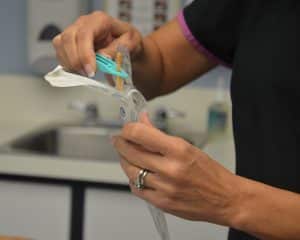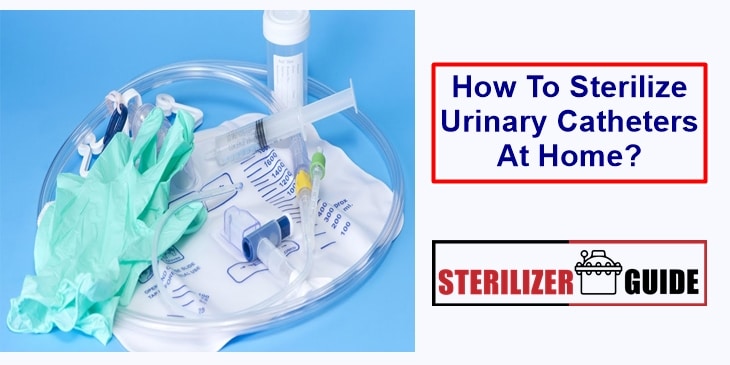A urinary catheter is inserted into the urethra and is used to treat a variety of abnormalities, including incontinence and difficulty in passing urine. This is a difficult procedure that requires care in the handling and cleaning of the urinary catheter. Providing the patient with a high-quality, sterile catheter can be a challenging task for the healthcare provider, but a little preparation and attention to detail will make this task an easier one.
Urine is known to carry a variety of bacteria, which can cause UTI and bladder issues. In order to prevent these issues, you should sterilize your catheters before using them. The blog will discuss how to sterilize urinary catheter at home and the potential solutions to doing it the right way.
What are the benefits of sterilizing catheters?

Catheters are medical devices used for urinary retention. Catheters are typically a flexible tube that is inserted into the urethra, where it helps to remove urine from the bladder. A properly-sterilized catheter can help to remove the risk of infection-causing bacteria from the urethra, which could lead to the development of urinary tract infections.
Sterilizing your catheter before and after each use can help to prevent infections and irritation. If you have a catheter, you should sterilize it before and after use to ensure that you are getting the most out of your medical equipment and to make sure your catheter is safe to use.
Remember, if you are using a catheter for a long period of time, you should consider using a disposable catheter. This will make your life easier.
How to sterilize urinary catheters and prevent infection?

When an individual is unable to use the toilet, the urinary catheter is used to collect urine. Most people don’t realize that urinary catheters can’t be sterilized using traditional methods. Which means that these are a perfect place for infections to breed.
To prevent infections and maintain sterility, these catheters must be properly sterilized. You may be wondering how to sterilize catheters at home. There are several ways to sterilize a catheter and prevent infection. Let’s see the best ways to sterilize urinary catheters at home.
How to sterilize urinary catheters with boiling water?
When a person receives a catheter, they are usually given a set of instructions on how to care for it. However, the instructions can be confusing and can easily lead to problems. One problem that can occur is a urinary tract infection. To avoid a urinary tract infection, you should sterilize your catheter after each use. The best way to sterilize your catheter is by boiling it for 10 minutes in a low heat setting.
When preparing to sterilize your catheter, you will need to fill a pot of boiling water and place the catheter in it. You will need to leave it there for ten minutes in low heat.
You can also boil it in a pot of water and make a solution with a few drops of bleach. If you boil it in bleach, make sure that you do not inhale the fumes. Then rinse with cold water. Once your catheter is sterilized, you can put it back in your bladder.
How to sterilize urinary catheters with hydrogen peroxide?
Sterilization is the process of killing bacteria on a medical item, like a catheter, by using a chemical called hydrogen peroxide. Hydrogen peroxide is a strong oxidizing agent that requires a 3% concentration to kill bacteria and a 10% concentration to sterilize it.
To sterilize a catheter, add hydrogen peroxide to warm water and mix it together. Then, dip the catheter into the solution for 30 – 40 seconds. The catheter should be immersed in the hydrogen peroxide at a deep enough depth that the catheter is completely submerged without allowing any of the hydrogen peroxide to come out. Lastly, rinse the catheter with cold water.
This is the most reliable method for sterilizing the catheter. Remember, Hydrogen peroxide at a 10% concentration is a strong oxidizing agent, so using it is not recommended on silicone catheters.
How to sterilize urinary catheters with alcohol?
Sterilizing urine catheters can be difficult for some people. There are some methods of sterilizing urine catheters that are commonly used by healthcare providers. However, these methods are not always used at home. One of the best ways to sterilize your catheter is to use alcohol as a sanitizer.
Alcohol works best as it allows you to sterilize the catheter in a short amount of time. You need to soak the catheter in a solution of 70% alcohol and 30% water for 10 minutes. After 10 minutes, the catheter should be rinsed with water for 2 minutes and then left to dry.
How can you keep your catheter clean for a long period of time?
Catheters can be helpful, but they can also be harmful to your health. They are also a way for bacteria to enter your body that can cause infections. As a result, it is important to keep your catheter clean at all times so that it can be used for a long period of time.
To keep your catheter clean, what you can do is store it in a zipper mesh laundry bag and then store it in a clean jar. If you want to store your catheter for a long period of time, you can also purchase a catheter cleaning kit.
You can put your catheter in a closed bag and then put it in the freezer. When you’re ready to use it, you can take it out and it will be clean. To keep your catheter clean, you can also use pre-moistened wipes.
Another way to keep your catheter clean is to use a catheter holder. With this, you can easily store your catheter by putting it into the holder.
Wrapping Up
We hope you enjoyed our blog post about how to sterilize urinary catheter at home. Urine catheters are a necessary part of managing urinary incontinence, but using them improperly can lead to some serious health problems. If you are able to sterilize your catheter, you can use it for as long as you need.
We know that this can be a difficult process. But we want to make sure that you know everything there is to know about your catheter so that you can be successful during this process. We would love to hear from you, so please contact us anytime if you have any questions or concerns. Thank you for reading, we would love to hear from you!

